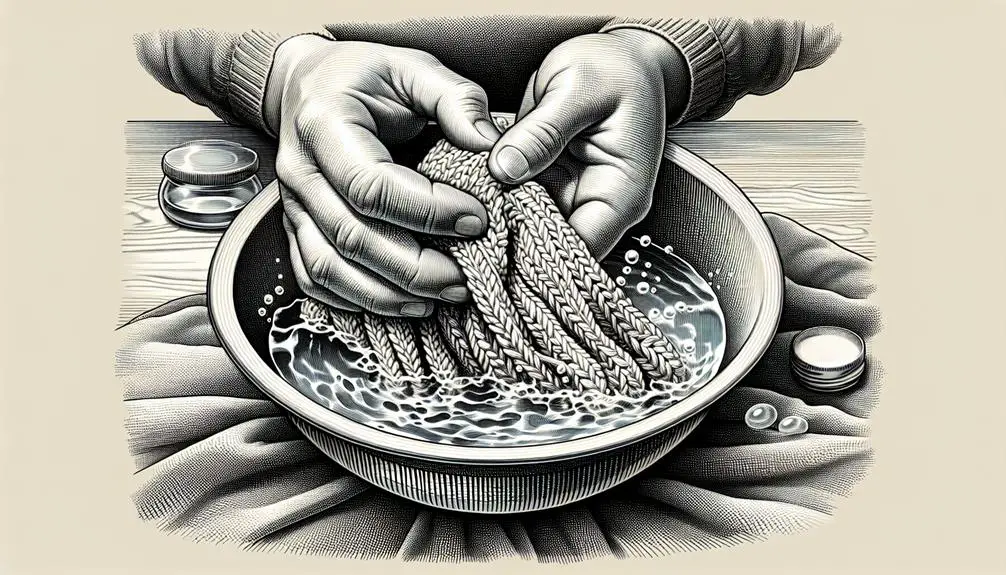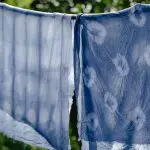When it comes to washing crochet, it's essential to handle it with care, much like tending to delicate flowers in a garden.
But have you ever wondered what the best way to wash your treasured crochet pieces is?
Let's explore the secrets to keeping your crocheted items looking fresh and vibrant, ensuring they last for years to come.
Table of Contents
Key Takeaways
- Hand wash crochet items with mild detergent in cold water to preserve quality.
- Use eco-friendly detergents for delicate fibers to minimize environmental impact.
- Lay flat to dry away from direct sunlight to maintain shape and color.
- Store in breathable cotton bags in a cool, dark area to prevent damage.
Proper Pre-Wash Preparation
Before tossing your crochet project into the washing machine, take a moment to ensure all loose ends are secure to prevent unraveling during the wash cycle. Care instructions are crucial for maintaining the integrity of your handmade items. For delicate pieces or those with intricate designs, hand washing is often the best choice.
Use a mild detergent to gently clean the crochet without causing damage. When hand washing, fill a basin with lukewarm water and a small amount of the mild detergent. Gently agitate the water to distribute the soap. Submerge the crochet item and let it soak for a few minutes. Avoid wringing or twisting the fabric, as this can distort the shape.
After washing, gently press out excess water and then lay the item flat to dry. This method helps preserve the shape and texture of your crochet work, ensuring that it lasts for years to come.
Choosing the Right Detergent
When it comes to washing crochet pieces, choosing the right detergent is crucial. Opt for gentle detergents that are specifically designed for delicate fibers like those found in crochet projects.
Consider eco-friendly options that are pH-balanced to keep your items in top condition.
Gentle Detergents Recommended
For delicate crochet items, selecting a mild laundry liquid such as Ecover Delicate Laundry Liquid is recommended to ensure gentle cleaning. When caring for your crochet projects, it's essential to choose the right detergent to maintain their quality. Here are some tips for selecting gentle detergents:
- Choose mild laundry liquids: Opt for products specifically designed for delicate and wool fibers to prevent damage.
- Avoid harsh detergents: Steer clear of powder detergents and capsules that may be too strong for crochet items.
- Consider specialized options: Look for detergents like Eucalan Delicate Wash or Soak, which are gentle on delicate fabrics.
- Use the dispenser drawer: When washing crochet items, place the detergent in the machine's dispenser drawer for even distribution.
Consider Eco-Friendly Options
To prioritize environmental considerations when selecting detergents for washing crochet, opt for eco-friendly options labeled as biodegradable and containing plant-based ingredients. Eco-friendly detergents are a great choice to minimize the impact on the environment while keeping your crochet items clean and fresh. Below is a table summarizing some eco-friendly detergents and fabric softeners that are gentle on both your crochet pieces and the planet:
| Eco-Friendly Option | Key Features |
|---|---|
| Seventh Generation | Biodegradable, plant-based |
| Ecover | Phosphate-free |
| Mrs. Meyer's | Cruelty-free |
| Method | Recyclable packaging |
| Biokleen | Non-toxic formula |
Ph-Balanced for Delicate Fibers
Select a pH-balanced detergent tailored for delicate fibers such as wool or cashmere to ensure optimal care during washing. When choosing a detergent, consider the following:
- pH-Balanced Formula: Ensures the detergent is gentle on fibers and prevents damage or weakening during washing.
- Designed for Delicate Fibers: Specifically formulated for natural fibers like wool and cashmere to maintain their integrity.
- Prevents Shrinkage and Stretching: Gentle detergents help prevent unwanted changes to the fabric's size or shape.
- No Harsh Chemicals: Avoid detergents with strong chemicals that can strip natural fibers of their softness and sheen.
Ideal Water Temperature for Crochet
Why is cold water the ideal choice for washing crochet items? Cold water is the best option for washing crochet because it helps prevent shrinkage and damage to delicate fibers. When it comes to yarn care, using cold water is essential to maintain the shape and color of your crochet projects. Warm or hot water can lead to felting or distortion of the fibers, which is why cold water is preferred. By following yarn care instructions and washing crochet items in cold water, you ensure the longevity of your handmade pieces.
| Cold Water Benefits | Description |
|---|---|
| Prevents shrinkage | Cold water helps maintain the size of crochet items. |
| Preserves color | Cold water prevents color fading during washing. |
| Gentle on fibers | Cold water is gentle on delicate yarn fibers. |
| Maintains shape | Helps keep the shape of the crochet project intact. |
| Prevents distortion | Cold water prevents excessive stretching or distortion. |
Gentle Washing Techniques
When it comes to washing crochet items, using cold water and a mild detergent is key to maintaining their quality.
It's important to handle them gently, avoiding any harsh wringing or scrubbing that could cause damage.
Proper drying methods, like squeezing out excess water carefully and laying flat to dry, help to preserve the shape of your crocheted pieces.
Water Temperature
To maintain the quality and longevity of your crochet items, it's essential to carefully consider the water temperature used during washing. When washing crochet items, here are some tips to help you choose the right water temperature:
- Cold Water: Use cold water for washing crochet items to prevent shrinking and damage.
- Warm Water: Warm water can be used for more durable fibers like cotton or synthetic blends.
- Avoid Hot Water: Hot water should be avoided as it can cause colors to bleed and affect the texture of the yarn.
- Adjust Accordingly: Adjust the water temperature based on the yarn type and any specific care instructions provided.
Following these guidelines on water temperature ensures the longevity and quality of your crochet projects.
Drying Methods
For optimal results when drying crocheted items, it is advisable to lay them flat to preserve their shape and prevent stretching. After gently washing your crochet piece, follow these steps to ensure proper drying:
| Step | Description |
|---|---|
| Lay flat | Place the crocheted item on a flat surface to dry. |
| Towel on a flat | Gently press a towel on top of the item to absorb excess water before laying it flat to dry. |
| Rotate | Rotate the item periodically during the drying process to ensure even drying on all sides. |
| Air dry naturally | Allow the crocheted item to air dry naturally to prevent damage that may be caused by high heat dryers. |
| Avoid spin cycle | Do not put crocheted items in the spin cycle of the washing machine to prevent stretching. |
Effective Drying Methods
One effective way to dry crochet items is by laying them flat to maintain their shape and prevent stretching. After gently squeezing out excess water using a dry towel, follow these steps for effective drying:
- Choose a Flat Surface: Select a clean, dry surface like a towel or a mesh drying rack to lay your crochet item flat. This will help it retain its original shape.
- Flip Periodically: For larger items like blankets or shawls, remember to flip them periodically during the drying process. This ensures that both sides dry evenly.
- Avoid High Heat: Refrain from using high-heat dryers as they can damage delicate fibers found in many crochet items, such as wool or acrylic.
- Ensure Complete Dryness: Make sure your crochet piece is completely dry before storing it away. This helps prevent the development of mildew or musty odors.
Reshaping Crochet Items
When reshaping crochet items after washing, gently mold them back to their original form while they are still damp. It's essential to handle the damp crochet piece carefully to avoid stretching or damaging it. Here are some steps to effectively reshape crochet items:
| Step | Description | Importance |
|---|---|---|
| Check the care label | Review the care instructions on the item's label to ensure you reshape it correctly. | Ensures you follow manufacturer recommendations. |
| Reshape the item | Gently stretch and mold the crochet piece back to its original shape, paying attention to edges and corners. | Maintains the item's design and size. |
| Use blocking mats and pins | For intricate pieces, employ blocking mats and pins to help maintain the desired shape during the drying process. | Assists in reshaping detailed crochet items. |
| Air dry completely | Allow the reshaped item to air dry fully before removing any pins or blocking tools to avoid distortion and preserve the item's shape. | Prevents deformation and ensures the desired outcome. |
| Avoid using the washing machine | Reshaping crochet items by hand is recommended to prevent damage that may occur in a washing machine. | Handwashing preserves the integrity of the crochet piece. |
Addressing Stains on Crochet
Address stains on your crochet items promptly to prevent them from setting in permanently. When dealing with stains on crochet pieces, it's crucial to consider the type of yarn and the nature of the stain for effective removal. Here are some tips to help you tackle stains on your beloved crochet items:
- Identify the Stain: Before attempting any stain removal method, identify the type of stain you're dealing with. Different stains may require specific treatments to avoid damaging the yarn.
- Choose the Right Method: Select a stain removal method suitable for the yarn used in your crochet item. Delicate fibers require gentle treatment, while sturdier yarns can withstand slightly more robust cleaning techniques.
- Test Before Applying Widely: Always test any stain removal product on a small, inconspicuous area of the crochet item to ensure it doesn't cause discoloration or damage.
- Seek Professional Help: For stubborn or complex stains that you're unsure how to handle, consider consulting stain removal guides or professionals to prevent further damage while effectively removing the stain.
Storage Tips for Crochet Pieces
To properly preserve crochet pieces, it's essential to store them in breathable cotton bags or bins to prevent moisture build-up. Storing crochet items in breathable containers helps maintain their quality by reducing the chances of mold or mildew developing due to trapped moisture.
Hanging crocheted pieces can lead to stretching and distortion over time, so it's best to fold or lay them flat to retain their shape. Additionally, keeping crochet pieces in cool, dark closets away from direct sunlight can help preserve their colors from fading or changing over time.
Rotating stored crochet items occasionally can prevent creases and ensure that all parts of the piece age uniformly. By following these storage tips, you can help prolong the lifespan of your crochet pieces and keep them looking fresh and vibrant for years to come.
Frequently Asked Questions
Can Crochet Be Washed in Washing Machine?
Absolutely, I toss my crochet pieces in the washing machine. I use a delicates bag, cold water, and a gentle cycle to keep them safe. Following yarn label care instructions is my secret recipe for success!
How Do You Wash Things You've Crocheted?
To wash things I've crocheted, I gently hand wash in cold water with mild detergent to keep them looking great. I skip wringing or scrubbing, just swish and rinse gently. Then, I lay them flat to dry.
Does Crochet Shrink When Washed?
Crochet, like a delicate flower, can shrink when washed, especially if made from natural fibers. I've learned to avoid high heat and opt for cold water with gentle detergent to prevent shrinkage.
How Do You Wash and Block Crochet?
To wash and block crochet, I fill a basin with cold water and gentle detergent. After swishing the piece, I rinse it in fresh cold water until clear. To block, I reshape the damp item for desired sizing.
- Kevlar Non-Woven Fabric: Non-Sewing Applications - June 21, 2025
- Kevlar Net Fabric: Fishing and Rescue Netting - June 21, 2025
- Kevlar and Neoprene Fabric: Hybrid Composites Explained - June 21, 2025




